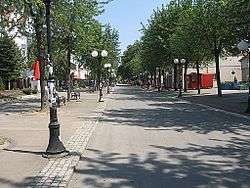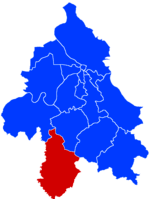Lazarevac
| Lazarevac Лазаревац | ||
|---|---|---|
| Municipality | ||
   Clockwise, from top: Town center promenade, Municipal Building, Orthodox Church | ||
| ||
 Location of Lazarevac within the city of Belgrade | ||
| Coordinates: 44°22′N 20°15′E / 44.367°N 20.250°ECoordinates: 44°22′N 20°15′E / 44.367°N 20.250°E | ||
| Country |
| |
| City | Belgrade | |
| Settlements | 1 | |
| Government | ||
| • Mayor | Dragan Alimpijević (SPS) | |
| Area[1] | ||
| • Urban | 17.86 km2 (6.90 sq mi) | |
| • Municipality | 382.77 km2 (147.79 sq mi) | |
| Elevation | 161 m (528 ft) | |
| Population (2011 census)[2] | ||
| • Urban | 25,526 | |
| • Urban density | 1,400/km2 (3,700/sq mi) | |
| • Municipality | 58,224 | |
| • Municipality density | 150/km2 (390/sq mi) | |
| Time zone | UTC+1 (CET) | |
| • Summer (DST) | UTC+2 (CEST) | |
| Postal code | 11550 | |
| Area code | +381(0)11 | |
| ISO 3166 code | SRB | |
| Car plates | BG | |
| Website |
www | |
Lazarevac (Serbian Cyrillic: Лазаревац, pronounced [lazareʋat͡s]) is a municipality of the city of Belgrade. As of 2011, the town has a total population of 25,526 inhabitants, while the municipal area has a total of 58,622 inhabitants.
Its name stems from the name of medieval Serbian ruler Prince Lazar Hrebeljanović.[3]
History
During the Interbellum, there was an auxiliary military airfield in Lazarevac, part of the air defense of the state capital, Belgrade. On 7 April 1941, during the German bombing of Belgrade, air force unit "Arad", employing 60 Stuka airplanes bombed the airfield in an effort to destroy as many Yugoslav planes as possible. A majority of planes, used for training flights, were either destroyed or demolished. Nine airmen were killed in action: Luka Stojanović, Lazar Štarbeger, Labud Egić, Senta Milenković, Lazar Ivančević, Tihomir Simeunović, Petar Stanojević, Krojač Stančelović and Miodrag Ž. Mihailović. Except for Stojanović, they were all buried at the Lazarevac cemetery. The Memorial Church of St.Demetrius, with ossuary, was also damaged in the attack. The area of the former airfield is today occupied by the health center "Dr Đorđe Kovačević" and the Special Hospital for the endemic nephropathy, but neither the location nor the graves are marked in memory of the 1941 events. In 1984 one of the town streets was named after the killed airmen, albeit erroneously: instead of "Nine airmen", the street was named "Six airmen". In January 2018, dedication of the memorial plaque on the location of the former airfield is announced.[4]
In 1971, the municipality of Lazarevac, along with Mladenovac, was annexed to the city of Belgrade.
Demographics
| Historical population | ||
|---|---|---|
| Year | Pop. | ±% p.a. |
| 1948 | 36,377 | — |
| 1953 | 38,794 | +1.29% |
| 1961 | 43,906 | +1.56% |
| 1971 | 45,675 | +0.40% |
| 1981 | 51,068 | +1.12% |
| 1991 | 58,882 | +1.43% |
| 2002 | 58,511 | −0.06% |
| 2011 | 58,622 | +0.02% |
| Source: [5] | ||
The municipality of Lazarevac has a total population of 58,622 inhabitants, according to the 2011 census results.
Ethnic groups
The ethnic composition of the municipality (as of 2011):[6]
| Ethnic group | Population |
|---|---|
| Serbs | 55,987 |
| Romani | 650 |
| Montenegrins | 166 |
| Macedonians | 66 |
| Croats | 47 |
| Yugoslavs | 45 |
| Muslims | 45 |
| Romanians | 29 |
| Hungarians | 21 |
| Russians | 20 |
| Slovenians | 16 |
| Albanians | 12 |
| Others | 1,518 |
| Total | 58,622 |
Economy
Lazarevac is the home to the Serbian largest coal mining and smelting complex RB Kolubara.
The following table gives a preview of total number of employed people per their core activity (as of 2016):[7]
| Activity | Total |
|---|---|
| Agriculture, forestry and fishing | 19 |
| Mining | 8,750 |
| Processing industry | 3,119 |
| Distribution of power, gas and water | 1,176 |
| Distribution of water and water waste management | 813 |
| Construction | 848 |
| Wholesale and retail, repair | 1,862 |
| Traffic, storage and communication | 643 |
| Hotels and restaurants | 667 |
| Media and telecommunications | 83 |
| Finance and insurance | 213 |
| Property stock and charter | 2 |
| Professional, scientific, innovative and technical activities | 335 |
| Administrative and other services | 1,810 |
| Administration and social assurance | 554 |
| Education | 872 |
| Healthcare and social work | 776 |
| Art, leisure and recreation | 115 |
| Other services | 160 |
| Total | 22,772 |
Attractions
One of the main attaractions in Lazarevac is the Church of St.Demetrius. It is basically a mausoleum, built in the memory of Serbian and Austro-Hungarian army soldiers that were killed at the Battle of Kolubara and tens of thousands of killed soldiers, both Serbian and Austro-Hungarian, were buried in the memorial ossuary of the church's crypt.[8] "The Committee to raise a memorial church and crypt in Lazarevac" was established in order the build the church. In the 1937 Committee was disbanded and "The Society for raising a memorial church with crypt in Lazarevac" was formed instead, led by a priest Borivoje Đorđević. Finally, the temple was built by the Russian émigré architect Ivan Afanasjevič Rik between 1938 and 1941.[9] In the architectural and urban environment of Lazarevac, the temple stands as a significant achievement of interwar Serbian church architecture.[10]
There is also a Modern gallery in the town, with the rich collection of paintings, graphics and sculptures, the "Kamengrad" ("Stoneville"), a park enriched with the stone sculptures chiseled by Bogosav Živković, and a Cultural Center. Outside of the town there are three wooden churches from the 18th century, a spring of natural mineral water and several archaeological finds. Other touristic features in the vicinity of Lazarevac include the Ćelije monastery and the Vrače hill, where Dimitrije Tucović, Serbian socialist theorist, was killed in November 1914 during the Battle of Kolubara.[8][11]
In Baroševac on the bank of the Kolubara grow a grove of giant sequoia trees which were brought from California to be studied and planted in Europe. The trees had only reached a height of 30m as of 2011, and are continuing to be studied as they develop in this manufactured habitat.[12]
There is a game hunting ground "Kolubara" in the municipality.[13]
See also
References
- ↑ "Municipalities of Serbia, 2006". Statistical Office of Serbia. Retrieved 2010-11-28.
- ↑ "2011 Census of Population, Households and Dwellings in the Republic of Serbia: Comparative Overview of the Number of Population in 1948, 1953, 1961, 1971, 1981, 1991, 2002 and 2011, Data by settlements" (PDF). Statistical Office of Republic Of Serbia, Belgrade. 2014. ISBN 978-86-6161-109-4. Retrieved 2014-06-27.
- ↑ "Kako je Lazarevac dobio ime". Moja Srbija (in Serbian). mojasrbija.rs. 12 August 2014. Retrieved 10 September 2017.
- ↑ Branka Vasiljević (31 January 2018). "Bombardovanje aerodroma u Lazarevcu zaboravljena priča" [Lazarevac airfield bombing - forgotten story]. Politika (in Serbian). p. 17.
- ↑ "2011 Census of Population, Households and Dwellings in the Republic of Serbia" (PDF). stat.gov.rs. Statistical Office of the Republic of Serbia. Archived from the original (PDF) on 14 July 2014. Retrieved 11 January 2017.
- ↑ "ETHNICITY Data by municipalities and cities" (PDF). stat.gov.rs. Statistical Office of Serbia. Retrieved 1 March 2018.
- ↑ "ОПШТИНЕ И РЕГИОНИ У РЕПУБЛИЦИ СРБИЈИ, 2017" (PDF). stat.gov.rs (in Serbian). Statistical Office of the Republic of Serbia. Retrieved 22 June 2018.
- 1 2 Dimitrije Bukvić (12 December 2008), "Kopovi "Kolubare" - biser industrijskog turizma", Politika (in Serbian)
- ↑ Spomenici kulture
- ↑ Cultural monument of outstanding value, Memorial Church in Lazarevac
- ↑ Dimitrije Bukvić (26 March 2011). "Turistički prsten na sat od kruga "dvojke"" (in Serbian). Politika.
- ↑ Novosti - Lazarevac: High redwood sprouting from coal (Serbian)
- ↑ Branka Vasiljević (5 August 2018). "Lovci u Beograd stižu porodično" [Hunters travel to Belgrade with their families]. Politika (in Serbian).
External links
| Wikimedia Commons has media related to Lazarevac. |



